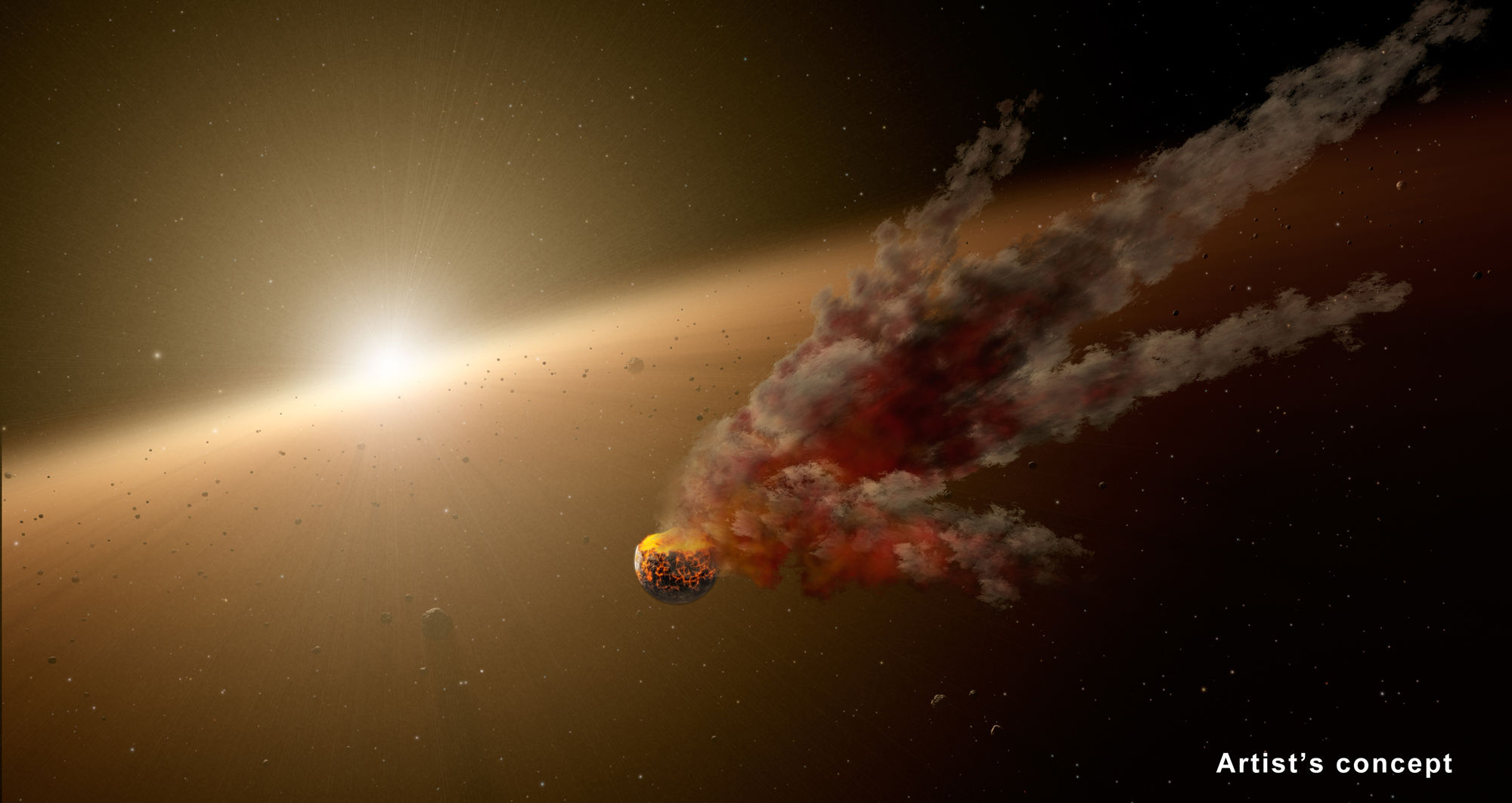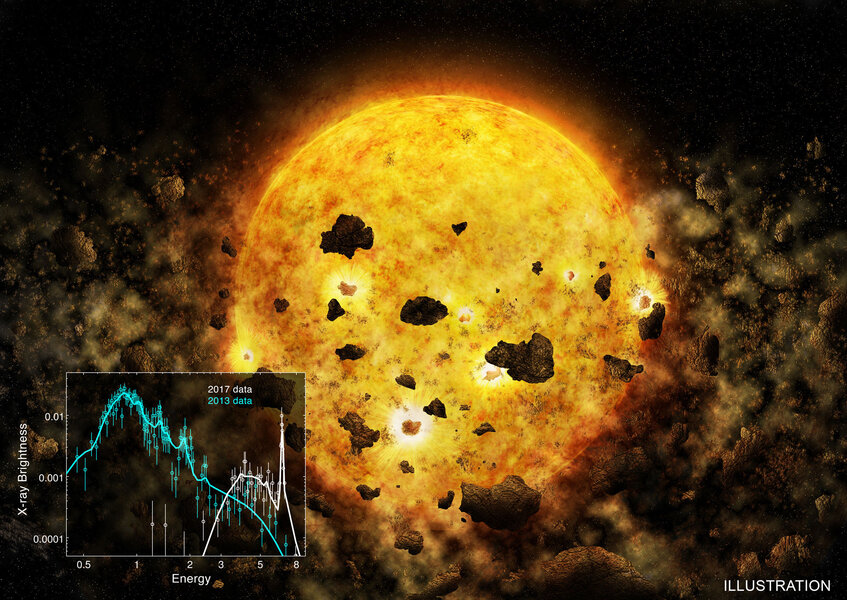Create a free profile to get unlimited access to exclusive videos, sweepstakes, and more!
Possible planet smashup in a young star system

Our solar system is pretty stable, overall, but it wasn't always that way. We know that in the early days, as planets were forming, there were some catastrophes. Planetesimals — smaller objects that grew larger by accumulating material around them — could collide, sometimes hard enough to shatter them. Even fully grown planets could smash into each other, sowing destruction on an amazing, crushing scale. Entire planets destroyed! Incredible!
Except it's entirely credible. And new observations imply very strongly that we just witnessed exactly such an event around a nearby star.
The star is called RW Aurigae, and it's a few hundred light years from Earth (I see lots of different measurements for it, from 210 to 450 light years distant). It's actually a binary star, two stars orbiting one another. One (called RW Aur A) is about 1.4 times the mass of the Sun, the other (RW Aur B) 0.9, and they are separated by a distance of about 30 billion kilometers (10 times farther than Neptune is from the Sun). It takes about 1,000 years for them to orbit each other.
These stars are young, probably only about 10 million years old. Remember, our solar system is 4.6 billion years old! RW Aur is barely done being born, and in fact RW Aur A is still surrounded by a disk of gas and dust from which planets form. By ten million years, planet formation should be well on its way, with several planet-sized bodies there and lots of smaller ones. We don't see them directly (they'd be in that disk, and also hidden by the glare of the star), but that's what we see in lots of other systems.
Every now and again, observers have noted dips in the brightness of RW Aur. Deep ones, where light dips down by a factor of 6 or so. After a few months, it rebrightens back to normal. This happened in 1937, for example, and in 1987.
It also happened again in 2011, and again after about six months it returned to normal brightness. But this time the pattern repeated much more rapidly: There was another, deeper dip in 2015, then another in 2016, and another in 2017. Something weird was going on.
Something weird indeed. Observations using the orbiting Chandra X-ray Observatory during the 2017 dip showed something quite extraordinary: There was a very bright flare-up in X-rays coming from RW Aur A, the more massive of the two stars, the one with the disk. Not only that, the X-rays seen from the star showed that whatever the source of the flare-up was, it was very rich in iron, of all things.
Now, stars, especially young stars, can be very magnetically active, and this means they can have huge explosive events in their atmospheres (called stellar flares and coronal mass ejections). The Sun has these, and it's not even terribly magnetically active! But when these happen, you don't expect to see a sudden enrichment of iron. The amount of iron stays the same, but the amount of X-rays emitted goes up.
That's not what was seen from RW Aur A. The iron increased a lot; normally the amount of iron seen in the star was less than what's seen in the Sun, but measuring the iron content during the flare-up indicated an abundance of iron 15 times the Sun's. Whatever happened, it looks like it injected a huge amount of iron into the star, about — are you ready for this? — 600 trillion tons. That's about 1 ten-millionth the mass of the Earth, or the equivalent of a solid chunk of iron something like 50 km across.
About the diameter of a decently sized planetesimal. Hmmmmm.
Putting this all together, this is what the astronomers think may have happened. In 2011, two biggish planetesimals orbiting in the disk around RW Aur A collided. The smashup created a big dust cloud that partially obscured the star, dimming the light we see. After a few months the cloud dispersed and the star's brightness returned to normal. The collision shattered the planetesimals, but some big pieces remained. They may have been sent on elliptical orbits, making subsequent collisions likely. That's what happened in 2015, then again in 2016 and 2017.
In 2017 the collision sent huge amounts of material sleeting toward the star. It fell into the star's corona, its super-heated outer atmosphere. The material then heated up itself and blasted out X-rays, creating the flare-up in the Chandra data as well as the enhanced iron levels.
Whoa.
Interestingly, no iron enhancement was seen in earlier Chandra observations; they were just seen in 2017. That makes me wonder… once a planetesimal gets to a certain size (a few hundred kilometers across), it starts to differentiate: Heavy stuff like nickel and iron falls to the core, while lighter stuff like silicates (rocks) floats to the surface. If the first collision in 2015 was not quite head-on, it could've sheared off a lot of the lighter stuff, leaving the iron core intact. Then the later collisions vaporized the now-exposed metal core. When it passed into the star's corona we got the bright flare and extra iron.
I'm guessing. But it's interesting. Grazing collisions are more common than head-on impacts, and we know that sort of thing happens (it's how our own Moon got its start). Again, I'm speculating, but hmmmm.
I'll note that there are other possibilities here — the astronomers note that the disk itself, or a wind of particles emanating from the disk, can explain some of the observations. But not all, and the idea of planet-shattering collisions does a better job. In my opinion that's the most likely scenario, though to be clear it hasn't been confirmed yet.
If so, wow. Events like that are relatively common in young planet-forming disks, but it looks like we've actually caught one in the act! What this says to me is that constant monitoring of the sky is important because there are events — big, catastrophic events — which we can miss if we only observe some things every now and then. It was the dimming in 2015 that triggered the Chandra observations, so keeping an eye on the sky, every kind of eye we can, pays off.



























